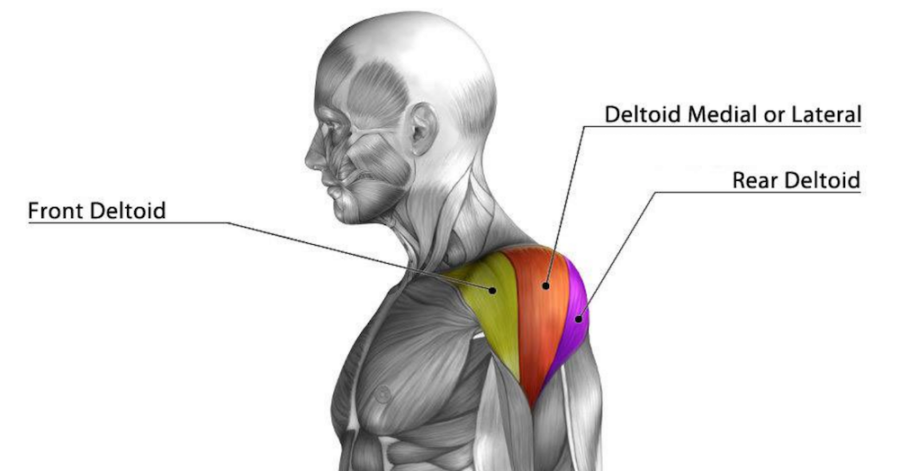Optimized Shoulder Training: Everything You Need to Know
The muscle group that, when fully developed, will make the most dramatic improvement to your physique is your shoulders. Fully developed shoulders provide the width to your upper body that accentuates the much-coveted v-shape. Rounded boulder shoulders also look impressive under a t-shirt. In a tank top, fully developed delts, with each of the 3 heads being clearly delineated, tells the world that you’re a huge, ripped beast.
In this article, you will learn everything you need to know to build shoulders that impress.
The deltoid muscle group is made up of three heads:
- The anterior head (front delt)
- The lateral head (side delt)
- The posterior head (rear delt)
Unlike the triceps, which also had three heads, each of the deltoid heads has a separate function with a unique direction of movement. That is because they have unique points of muscle fiber origin and insertion. As a result, deltoid training is unique in that different exercises are needed to work each of the heads.
The anterior deltoid originates on the outer half of the clavicle and inserts on the deltoid tuberosity on the humerus (upper arm). This is right alongside the insertion of the lateral head, which has its origin on the outer edge of the acromion process. The posterior deltoid originates on the upper ridge of the scapula and inserts on the deltoid tuberosity of the humerus, alongside the other two heads.
- The main function of the anterior head is to participate in pulling the humerus forward and upward, towards the clavicle.
- The function of the lateral head is to raise the arm out to the side.
- The primary function of the posterior head is to pull the arm back and, to a much lesser degree, to externally rotate the humerus.
For an exercise to be effective, it must mimic the natural movement of the muscle. In doing so, it will follow the direction of the muscle fibers from full contraction to full extension. If we can identify the single best exercise to work each of the deltoid heads, then we will be able to construct the ideal shoulder workout to maximally stimulate all 3 heads. The good news is that we can.
So, let’s do it …
Seated Anterior Deltoid Cable Press
The anterior deltoid is involved in pulling the arm forward and upward. When you do so with your palms facing down or away from you, (as in a bench press) there will be minimal delt involvement in favor of the pecs. But when you press forward with the palms facing up, you are maximally engaging the front delt.
Moving the arms from a right angle position at your sides with palms forward and then pressing them forward and slightly up in an arcing movement will perfectly mimic the functional movement of the anterior deltoid head. Try doing that movement right now and you will feel the front delt working even without any resistance.
The exercise that will best allow this movement is the seated anterior deltoid cable press. Here’s how to do it …
- Position a bench with a back pad 4 feet in front of a cable machine, facing away from it. Set the cables at elbow height when seated. Ideally, the distance between the cables should be shoulder width.
- Sit on the bench with cable handles in your hands.
- Start with your hands by your ribs, palms up and elbows bent.
- Press forward in a scooping motion to straighten the arms out in front of you.
- Reverse and repeat.
Cable Side Lateral Raise
The lateral head of the deltoid has one job only - to raise the arm out to the side, from the side of the body to a point where the humerus is almost perpendicular to the torso. The best exercise to simulate this movement is the standing one-arm side lateral raise. Doing this exercise with cables rather than dumbbells provides early phase loading so that there is more resistance in the first third of the movement and less resistance in the final third. Unlike dumbbells, the resistance does not diminish to zero at the end of the rep.
When setting up for the side cable raise, adjust the height of the pulley to the same level as your wrist in the starting position. Here is how to do the exercise …
- Stand side on to a cable machine about 3 feet in front of it. Grab the handle with your outside hand and your arm at your side.
- Pivot from the shoulder joint to bring your arm up and out to the side to a position just short of perpendicular.
- Lower under control and repeat.
- Repeat with the other arm.
It is important that you avoid the tendency to swing or otherwise use momentum when you do this exercise.
Cable Rear Delt Flye
The function of the rear deltoid head is to move the humerus back. The muscle fibers run diagonally downward. So, the ideal exercise that follows the direction of natural movement and the muscle fiber direction will have your arms moving diagonally downward and backward. The exercise that does that best is the cable rear delt flye, which is done as follows …
- Set the pulleys on a double cable machine at shoulder height and slightly wider than shoulder width apart.
- Remove the handles from the ends of the cables and stand about three feet in front of the machine, facing it.
- Grab the ends of the cables in a crossover manner, so that your left hand is holding the right cable and vice versa.
- From a starting position, your arms out straight and hands crossed over, bring your arms down diagonally all the way.
- Reverse under control and repeat.
Here’s a plan for women that will help you build your shoulders along with other body parts:
Here’s a workout program for men that will help you build your shoulders along with other body parts:
You now know the 3 best exercises that exist for complete shoulder development. They are the only exercises you ever need to do. Of course, there are dozens of other exercises you can do to add variety if you wish. Just be aware that none of them are as effective as these three, so you will be compromising your results.
As far as sets and reps go, I recommend a combination of high and low reps as follows.
- Set One - 30 reps
- Set Two - 20 reps
- Set Three - 15 reps
- Set Four - 10 reps
- Set Five - 8 reps
- Set Six - 6 reps
Perform the exercises in this order …
- Seated Anterior Deltoid Cable Press
- Cable Side Lateral Raise
- Cable Rear Delt Flye
Do this workout every 4-5 days for the best results. You’ll soon discover that focusing on maximally stimulating each deltoid head in turn is the key to developing thick, full, detailed shoulder muscles.
Frequently Asked Questions
The primary muscles involved in shoulder training are the deltoids, which consist of three heads: the anterior (front), lateral (side), and posterior (rear) deltoids. Each head has a unique function and requires specific exercises to target effectively.
The seated anterior deltoid cable press is an effective exercise for targeting the anterior deltoid. This exercise involves pulling the arm forward and upward with palms facing down or away, closely mimicking the natural movement of the muscle.
To ensure a balanced shoulder workout, include exercises that target each head of the deltoid: anterior, lateral, and posterior. This approach ensures that all parts of the shoulder are developed evenly, preventing muscle imbalances.
Well-developed shoulders contribute significantly to an impressive physique by enhancing the upper body's width and promoting a V-shaped appearance. They also improve overall body aesthetics, making muscles appear more defined and balanced.
To prevent shoulder injuries, ensure proper warm-up, use correct form, and avoid lifting excessively heavy weights. It's also beneficial to incorporate exercises that improve shoulder mobility and stability. For more tips, read 7 Tips on How to Prevent Shoulder Injury in The Gym.
Tracking your shoulder workout progress can be made easier with apps like the Gymaholic App, where you can log exercises, sets, and weights, and monitor improvements over time to ensure you're meeting your fitness goals.

